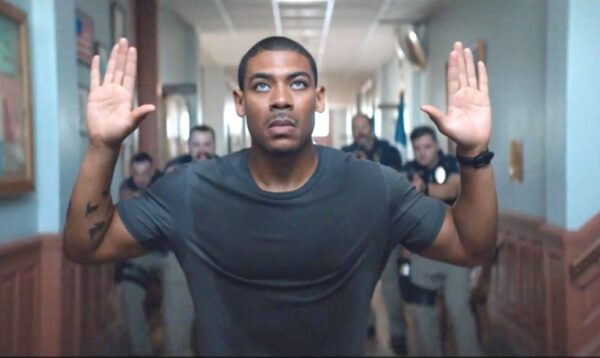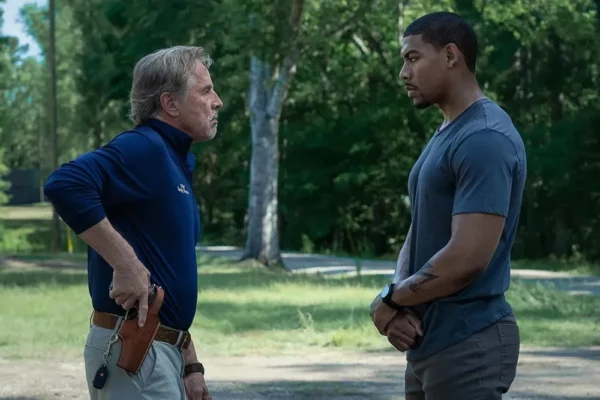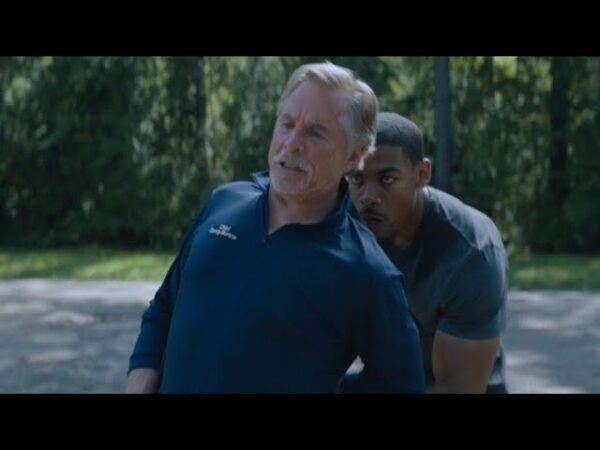„Rebel Ridge“: Calmly Burn the Whole Thing Down
Stop me if you’ve heard this one before: a righteous man rides into a corrupt town and cleanses it of sin. It’s Eastwood as the Man With No Name snarling You got a problem with my mule? and the Continental Op burning down Poisonville to save it and John Rambo blasting Main Street to kindling and…
Yeah, you’ve heard it before. It’s a genre trope with the tread worn off.
And that’s what makes “Rebel Ridge,” the new film by Jeremy Saulnier, so interesting: from a structural perspective, it hews to that trope: man rides into town, man is wronged by the local authorities, man fights back and knocks down the whole evil mess. But even as Saulnier works through the plot points, he subverts them.
When the film starts, Terry Richmond (Aaron Pierre) is bicycling into the small town of Shelby Springs with $36,000 in his backpack. He intends to use the money to pay bail for his cousin, but he’s detained by local cops who seize every cent under the bullshit guise of civil forfeiture. His attempts to talk through the situation with local police chief Sandy Burne (Don Johnson, alternately feral and slimy) only ratchet up the tensions, and Terry quickly realizes almost everyone in town is hopelessly corrupt—and want him gone or dead.
Under normal circumstances, a sleazy bureaucracy simply chews up people and spits them out. But Terry just happens to be a Marine veteran and an instructor in close-quarters combat; when things escalate, he puts those skills to use. One of the remarkable things about Pierre’s performance is how he fights with smooth, unstoppable motion, like part of a mountain sloughing down to bury everyone beneath; it almost seems slow before you realize he’s put at least three or four people on the ground. (In a certain way, it’s too bad this film is a Netflix release, because one cop’s freaked-out assessment of Terry’s skills—“He’s on the Wikipedia page! Teaching Jiu Jitsu to the 6th Marine regiment!”—would have killed in a theater.)
With most movies and books that execute this trope, the protagonist is a bonfire of moral rage who eventually burns the whole system to ash. They attempt to assuage that anger by leaving as many dead bodies as possible. But Terry, as befitting his martial-arts background, remains almost supernaturally calm throughout “Rebel Ridge,” even when the worst happens; during the final gunfight, which would’ve been a prime opportunity to ratchet up that body count, he’s focused on efficient action, methodically disabling folks without killing them (it’s the closest you could come to outright de-escalation when the bullets are flying).
While it might be tempting for a critic to call his anticlimactic, it allows Terry to maintain the moral high ground—which makes you realize the amorality of the trope despite its perpetual guise of righteousness. There’s a lot more to unpack in the film, including its undercurrents of racism and how civil forfeiture laws can turn a whole county government monstrous, and Saulnier hat-tips to them without slowing down his narrative.
“Rebel Ridge” would make a nice double feature with “Blue Ruin,” Saulnier’s 2013 film about the futility of revenge. In the latter film, what starts out as a straightforward, ostensibly moral attempt to avenge two deaths quickly transforms into a bloody debacle—once you start pulling the trigger, you can’t anticipate how things will spin out of control. “Rebel Ridge,” by contrast, shows how a protagonist can take a different route when faced with adversity, and it refreshes a very tired trope in the process.
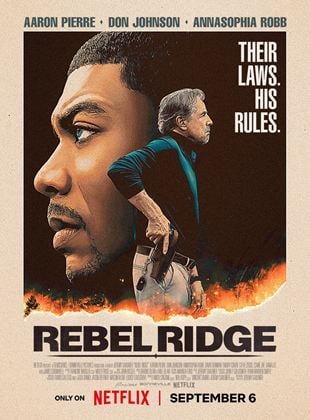
: Calmly Burn the Whole Thing Down
Stop me if you’ve heard this one before: a righteous man rides into a corrupt town and cleanses it of sin. It’s Eastwood as the Man With No Name snarling You got a problem with my mule? and the Continental Op burning down Poisonville to save it and John Rambo blasting Main Street to kindling and…
Yeah, you’ve heard it before. It’s a genre trope with the tread worn off.
And that’s what makes “Rebel Ridge,” the new film by Jeremy Saulnier, so interesting: from a structural perspective, it hews to that trope: man rides into town, man is wronged by the local authorities, man fights back and knocks down the whole evil mess. But even as Saulnier works through the plot points, he subverts them.
When the film starts, Terry Richmond (Aaron Pierre) is bicycling into the small town of Shelby Springs with $36,000 in his backpack. He intends to use the money to pay bail for his cousin, but he’s detained by local cops who seize every cent under the bullshit guise of civil forfeiture. His attempts to talk through the situation with local police chief Sandy Burne (Don Johnson, alternately feral and slimy) only ratchet up the tensions, and Terry quickly realizes almost everyone in town is hopelessly corrupt—and want him gone or dead.
Under normal circumstances, a sleazy bureaucracy simply chews up people and spits them out. But Terry just happens to be a Marine veteran and an instructor in close-quarters combat; when things escalate, he puts those skills to use. One of the remarkable things about Pierre’s performance is how he fights with smooth, unstoppable motion, like part of a mountain sloughing down to bury everyone beneath; it almost seems slow before you realize he’s put at least three or four people on the ground. (In a certain way, it’s too bad this film is a Netflix release, because one cop’s freaked-out assessment of Terry’s skills—“He’s on the Wikipedia page! Teaching Jiu Jitsu to the 6th Marine regiment!”—would have killed in a theater.)
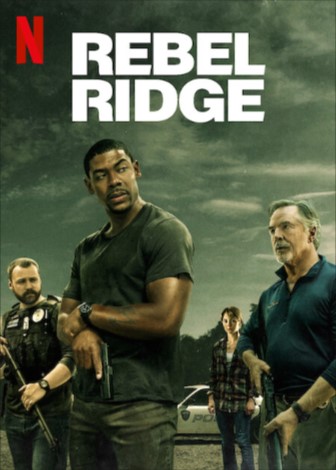
With most movies and books that execute this trope, the protagonist is a bonfire of moral rage who eventually burns the whole system to ash. They attempt to assuage that anger by leaving as many dead bodies as possible. But Terry, as befitting his martial-arts background, remains almost supernaturally calm throughout “Rebel Ridge,” even when the worst happens; during the final gunfight, which would’ve been a prime opportunity to ratchet up that body count, he’s focused on efficient action, methodically disabling folks without killing them (it’s the closest you could come to outright de-escalation when the bullets are flying).
While it might be tempting for a critic to call his anticlimactic, it allows Terry to maintain the moral high ground—which makes you realize the amorality of the trope despite its perpetual guise of righteousness. There’s a lot more to unpack in the film, including its undercurrents of racism and how civil forfeiture laws can turn a whole county government monstrous, and Saulnier hat-tips to them without slowing down his narrative.
“Rebel Ridge” would make a nice double feature with “Blue Ruin,” Saulnier’s 2013 film about the futility of revenge. In the latter film, what starts out as a straightforward, ostensibly moral attempt to avenge two deaths quickly transforms into a bloody debacle—once you start pulling the trigger, you can’t anticipate how things will spin out of control. “Rebel Ridge,” by contrast, shows how a protagonist can take a different route when faced with adversity, and it refreshes a very tired trope in the process.
** **
Nick Kolakowski is the author of „Maxine Unleashes Doomsday“ and „Boise Longpig Hunting Club“ as well as the Love & Bullets trilogy of novellas. His noir fiction has appeared in Tough, ThugLit, Mystery Tribune, Plots With Guns, and various anthologies. His „Payback is Forever“ (Shotgun Honey 2022) is inspired clearly by the novels of Richard Stark. Our review here (in German). – See also his Hell of a Mess. A Love & Bullets Hookup.

Nick Kolakowski, geboren 1980, aufgewachsen in Washington. D.C., hat Geschichte in Chicago studiert. Er schreibt Romane, Kurzgeschichten, Lyrik und Essays, viele davon über Crime Fiction und verwandte Themen. Seine Texte erscheinen u. a. in der Washington Post, in Shotgun Honey, North American Review, The Evergreen Review, Rust & Months. Kolakowski lebt in New York City. Eine Besprechung des von Parker inspirierten „Payback is Forever“ in unseren Bloody Chops.
Bei Suhrkamp auf Deutsch: Love & Bullets.
His essays with us.
His website nickkolakowski.com
His column „Smoking Gun“ with us:
‘Monsieur Spade’ and the Faustian Bargain
John Woo is Remaking ‘The Killer.’ But Why?
The Newest ‘Ripley’ Series is Stunning and Flawed
‘Sugar’: Not the Neo-Noir Revival We Need
Moral Redemption in Noir: Is It Possible?
What Makes Jack Reacher Tick?
‘True Detective: Night Country’ Tries to Make the Familiar into Something New
Is David Fincher’s ‘The Killer’ a Comedy?
Rewatching ‘Drive’: Gosling as Noir’s Apex Predator
Elmore Leonard – City Primeval
Cormac McCarthy Used Crime Fiction’s Tropes to Make Masterpieces
Parker: Donald Westlake’s One Amazing Trick
Cosby, Winslow, Pruitt: Three Heavy-Hitting Thillers for Summer
Weed-Based Crime Thrillers are Going Up in Smoke
‘The Last of Us’: Crime in the Post-Apocalypse
What Made “Glass Onion” and “Knives Out” So Popular?
Jordan Harper’s One-Two Punch of Crime Fiction Deserves a Wide Audience
‘True Detective’ Season 2: Was It Better Than We All Thought?
From ‘Touch of Evil’ to ‘True Detective,’ Long Shots are Crime Films’ Secret Weapon
Michael Mann, again: What Michael Mann Teaches Us About Enduring Crime Fiction
„Heat 2“ – How Do You Craft a Sequel to a Masterpiece?
4 Ways Tarantino’s “Once Upon a Time in Hollywood” Novel Stands Out From the Film.
On „Heat“: Manhunter Takes Down Thief: How Michael Mann’s Early Career Led to ‘Heat’
The Most Honest Nihilism – on „The Way of the Gun“
No, Time to Die – The latest James Bond movie digs into the fatalism at the iconic spy’s core.
Cormac McCarthy’s Overlooked Masterpiece? – „The Councelor“
„Nightmare Alley“ – How Guillermo del Toro’s Film Alters a Masterpiece Noir Novel
David Cronenberg – The Carnal Crime of “A History of Violence” and “Eastern Promises”
With Parker, Donald E. Westlake Pulled Off Crime Fiction’s Most Spectacular Magic Trick
Guy Ritchie’s Return to Crime Films is Worth Watching




